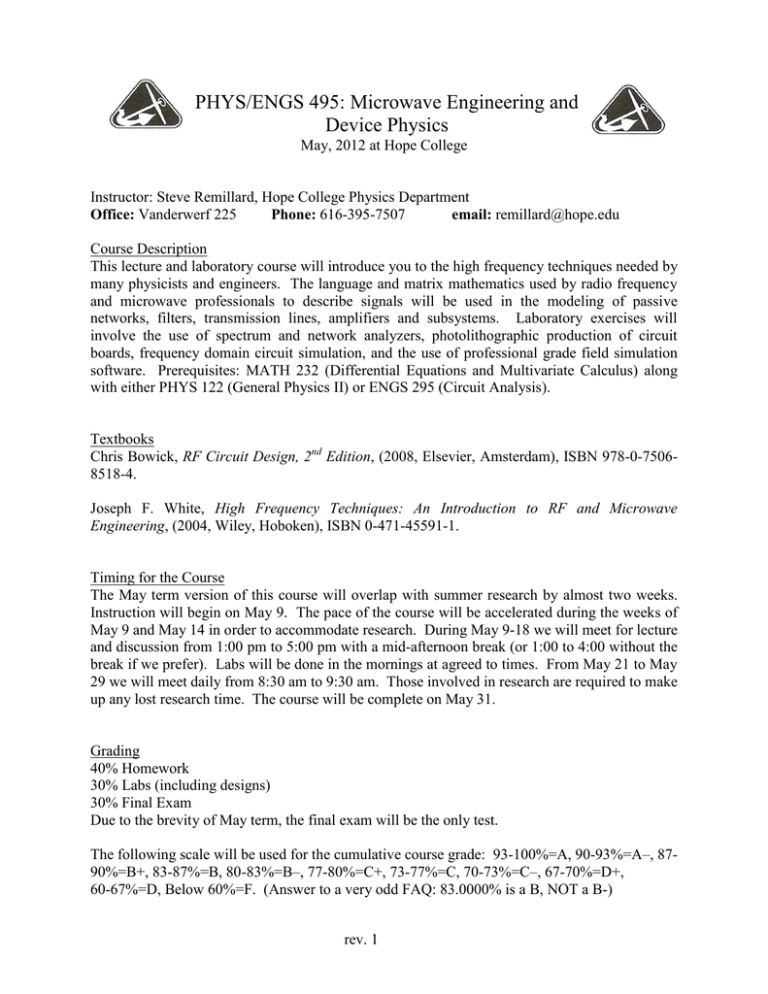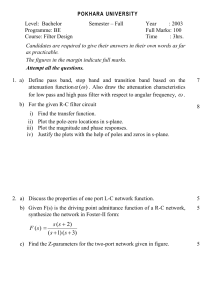PHYS/ENGS 495: Microwave Engineering and Device Physics
advertisement

PHYS/ENGS 495: Microwave Engineering and Device Physics May, 2012 at Hope College Instructor: Steve Remillard, Hope College Physics Department Office: Vanderwerf 225 Phone: 616-395-7507 email: remillard@hope.edu Course Description This lecture and laboratory course will introduce you to the high frequency techniques needed by many physicists and engineers. The language and matrix mathematics used by radio frequency and microwave professionals to describe signals will be used in the modeling of passive networks, filters, transmission lines, amplifiers and subsystems. Laboratory exercises will involve the use of spectrum and network analyzers, photolithographic production of circuit boards, frequency domain circuit simulation, and the use of professional grade field simulation software. Prerequisites: MATH 232 (Differential Equations and Multivariate Calculus) along with either PHYS 122 (General Physics II) or ENGS 295 (Circuit Analysis). Textbooks Chris Bowick, RF Circuit Design, 2nd Edition, (2008, Elsevier, Amsterdam), ISBN 978-0-75068518-4. Joseph F. White, High Frequency Techniques: An Introduction to RF and Microwave Engineering, (2004, Wiley, Hoboken), ISBN 0-471-45591-1. Timing for the Course The May term version of this course will overlap with summer research by almost two weeks. Instruction will begin on May 9. The pace of the course will be accelerated during the weeks of May 9 and May 14 in order to accommodate research. During May 9-18 we will meet for lecture and discussion from 1:00 pm to 5:00 pm with a mid-afternoon break (or 1:00 to 4:00 without the break if we prefer). Labs will be done in the mornings at agreed to times. From May 21 to May 29 we will meet daily from 8:30 am to 9:30 am. Those involved in research are required to make up any lost research time. The course will be complete on May 31. Grading 40% Homework 30% Labs (including designs) 30% Final Exam Due to the brevity of May term, the final exam will be the only test. The following scale will be used for the cumulative course grade: 93-100%=A, 90-93%=A–, 8790%=B+, 83-87%=B, 80-83%=B–, 77-80%=C+, 73-77%=C, 70-73%=C–, 67-70%=D+, 60-67%=D, Below 60%=F. (Answer to a very odd FAQ: 83.0000% is a B, NOT a B-) rev. 1 The usual syllabus matter: Some Tempting Opportunities for Academic Dishonesty in this Course: discussing a test or a quiz with someone who hasn’t taken it; using a homework website or a solution manual for assignments (plagiarism); copying homework instead of collaborating (also plagiarism); Copying off a neighbor during a test or a quiz. I wasn’t born yesterday and it is very hard to get away with systematic cheating under my watch. The penalty for cheating on homework or a test can be as severe as an F in the course, and will certainly result in a report to the provost. All work lecture and lab is subject to scrutiny for plagiarism. See http://www.hope.edu/lib/plagiarism/index.html for more details on Hope College’s policy on plagiarism and how to avoid it. Please see the college handbook for the full college policy on unethical behavior. Disabilities If you require accommodation for any kind of disability under ADA guidelines please contact me during the first week of the semester. Several useful services are also available from the Office of Disability Services (395-7805) and the Academic Support Center (395-7830) and you need to provide documentation of your accommodation requirement with these offices. Comments about email Please use your firstname.lastname@hope.edu email to communicate with your Hope faculty. Check your email daily for announcements. You are responsible for any announcement sent out by me to the class. Also, I would like to encourage you to always use face-to-face communication to provide feedback to your professors rather than email, as email “venting” so often results in regrettable one-way miscommunications. Extra Credit Policy Your grade in this course is determined by your performance on course requirements. These requirements are divided into homework, the exam, and labs. You have enough work to do just to perform well on the course requirements. If that performance is not going well, adding more work won’t help. Therefore, there is no extra credit in this course. rev. 1 Course Outline (30 lectures. Average length is 1 hour.) 1. Resistors, inductors and capacitors 2. Review of complex numbers 3. Maximum power transfer 4. Q matching with two component networks 5. The Smith Chart and impedance matching 6. Electromagnetism 1: Fields 7. Resonance 8. Antennas 9. Dielectrics 10. Matrix methods 11. Scattering parameters, standing wave ratio 12. Resonators and Q: Theory and measurement 13. Electromagnetism 2: Waves 14. The geometric components of the Q factor 15. Reactive circuits and resonators 16. Transmission lines: Overview 17. Transmission lines: Analytic 18. Propagation, group velocity, and phase velocity 19. Dispersion 20. Periodic transmission lines 21. Electromagnetism 3: Boundaries, Computation 22. Filter design 1 23. Filter design 2 24. Filter design 3 25. Noise 26. Low noise amplifiers 27. Nonlinearity 28. Cascaded devices 29. Miscellaneous components 30. Subsystems The laboratory exercises that must be completed by the end of the course are: (6 labs. Average length is 2 hours. Some more. Some less) Assignment Resource Rectangular resonant cavity Microwave Lab Coaxial resonant cavity HFSS and Microwave Lab Chebyshev bandpass filter paper design Maple and Genesys Three pole band-pass filter EM simulation IE3D Fabrication and test of the band-pass filter Fabrication in Photolithography Lab Amplifier nonlinearity Microwave Lab This course is cross-listed as ENGS 495 and taught in the Physics Department. rev. 1 Schedule* Date May 9 Reading White Chapter 1 White 2.1-2.7 May 10 White 2.8-2.14 May 11 White Chapter 3 Bowick pp. 63-72 White 5.1-5.3 White 7.1-7.12 White Chapter 6 Bowick pp.110-114 White 4.1-4.8 White 7.13-7.20 Bowick Chapter 2 White 4.9-4.15 White 7.21-7.25 White 9.1-9.6 White 9.7-9.10 May 14 May 15 May 16 May 17 May 18 May 21 May 22 May 23 May 24 May 25 May 28 White 10.11 Bowick 103-108 Bowick 115-123 Bowick 141-168 Handout on Cascaded Devices May 29 May 30 May 31 *subject to change Topics Introduction to radio frequency electronics Passive circuit elements at high frequency Circuit impedance and admittance Power, decibels and loss RLC circuits at high frequency Linear network simulation Simple matching networks The Smith Chart; Transmission line matching Electromagnetism 1 Matrix Methods (especially S-Parameters) Practical Transmission Lines Electromagnetism 2 Resonant Circuits Transmission Line Theory Electromagnetism 3 Filter Design 1 Filter Design 2 Filter Design 3 Noise Transistors at high frequencies Low noise amplifiers (LNAs) LNAs, Nonlinearity Catch-up & Review Memorial Day Final Exam rev. 1






